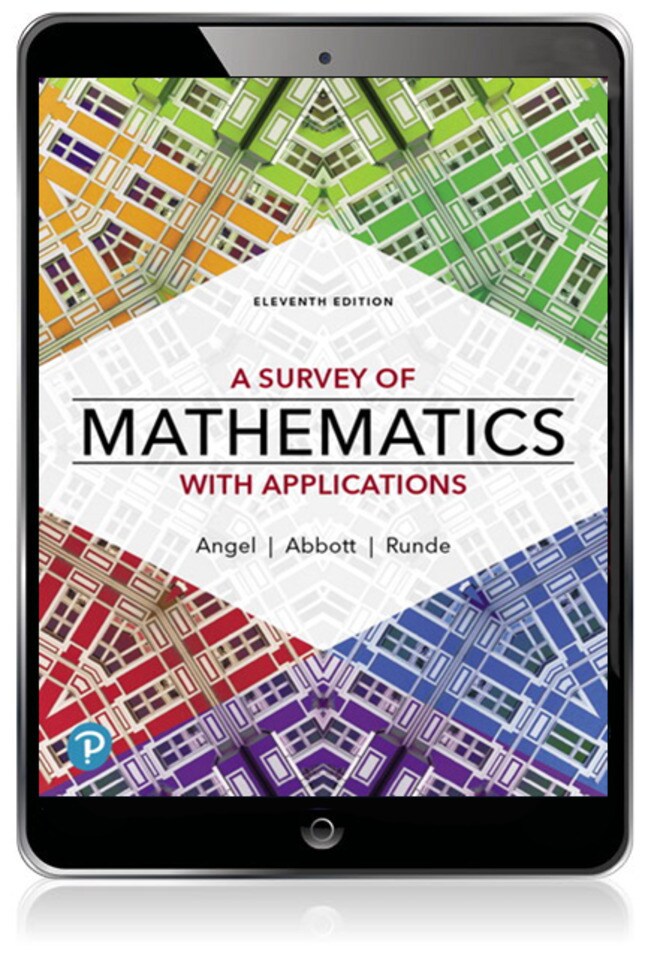
A Survey of Mathematics with Applications, 11th edition
- Allen R. Angel
- , Christine D. Abbott
- , Dennis Runde

- Watch and learn
Videos & animations bring concepts to life
- Listen on the go
Learn how you like with full eTextbook audio
- Find it fast
Quickly navigate your eTextbook with search
- Stay organized
Access all your eTextbooks in one place
- Easily continue access
Keep learning with auto-renew
Survey of Mathematics with Applications focuses on everyday math in everyday language, showing you how mathematics affects the world around us. With straightforward narrative, detailed examples and interesting applications, the authors demonstrate the importance of mathematics in daily life. Support for problem solving and exam prep helps you succeed in the course, with learning resources such as Critical Thinking Skills sections, Key Idea boxes, Timely Tips, Chapter Summaries, Review Exercises and Chapter Tests. The 11th Edition updates data throughout, revises Technology Tips, adds new Downloadable Data sets and more.
Published by Pearson (January 1st 2021) - Copyright © 2021
ISBN-13: 9780137409099
Subject: Liberal Arts Math
Category: Liberal Arts Math
- 1.1 Inductive and Deductive Reasoning
- 1.2 Estimation Techniques
- 1.3 Problem-Solving Procedures
- 2.1 Set Concepts
- 2.2 Subsets
- 2.3 Venn Diagrams and Set Operations
- 2.4 Venn Diagrams with Three Sets and Verification of Equality of Sets
- 2.5 Applications of Sets
- 2.6 Infinite Sets
- 3.1 Statements and Logical Connectives
- 3.2 Truth Tables for Negation, Conjunction, and Disjunction
- 3.3 Truth Tables for the Conditional and Biconditional
- 3.4 Equivalent Statements
- 3.5 Symbolic Arguments
- 3.6 Euler Diagrams and Syllogistic Arguments
- 3.7 Switching Circuits
- 4.1 Additive, Multiplicative, and Ciphered Systems of Numeration
- 4.2 Place-Value or Positional-Value Numeration Systems
- 4.3 Other Bases
- 4.4 Perform Computations in Other Bases
- 4.5 Early Computational Methods
- 5.1 Number Theory
- 5.2 The Integers
- 5.3 The Rational Numbers
- 5.4 The Irrational Numbers
- 5.5 Real Numbers and Their Properties
- 5.6 Rules of Exponents and Scientific Notation
- 5.7 Arithmetic and Geometric Sequences
- 5.8 Fibonacci Sequence
- 6.1 Order of Operations and Solving Linear Equations
- 6.2 Formulas
- 6.3 Applications of Algebra
- 6.4 Variation
- 6.5 Solving Linear Inequalities
- 6.6 Graphing Linear Equations
- 6.7 Solving Systems of Linear Equations
- 6.8 Linear Inequalities in Two Variables and Systems of Linear Inequalities
- 6.9 Solving Quadratic Equations by Using Factoring and by Using the Quadratic Formula
- 6.10 Functions and Their Graphs
- 7.1 Basic Terms and Conversions Within the Metric System
- 7.2 Length, Area, and Volume
- 7.3 Mass and Temperature
- 7.4 Dimensional Analysis and Conversions to and from the Metric System
- 8.1 Points, Lines, Planes, and Angles
- 8.2 Polygons
- 8.3 Perimeter and Area
- 8.4 Volume and Surface Area
- 8.5 Transformational Geometry, Symmetry, and Tessellations
- 8.6 Topology
- 8.7 Non-Euclidean Geometry and Fractal Geometry
- 9.1 Groups
- 9.2 Finite Mathematical Systems
- 9.3 Modular Arithmetic
- 9.4 Matrices
- 10.1 Percent
- 10.2 Personal Loans and Simple Interest
- 10.3 Compound Interest
- 10.4 Installment Buying
- 10.5 Buying a House with a Mortgage
- 10.6 Ordinary Annuities, Sinking Funds, and Retirement Investments
- 11.1 Empirical and Theoretical Probabilities
- 11.2 Odds
- 11.3 Expected Value (Expectation)
- 11.4 Tree Diagrams
- 11.5 OR and AND Problems
- 11.6 Conditional Probability
- 11.7 The Fundamental Counting Principle and Permutations
- 11.8 Combinations
- 11.9 Solving Probability Problems by Using Combinations
- 11.10 Binomial Probability Formula
- 12.1 Sampling Techniques and Misuses of Statistics
- 12.2 Frequency Distributions and Statistical Graphs
- 12.3 Measures of Central Tendency and Position
- 12.4 Measures of Dispersion
- 12.5 The Normal Curve
- 12.6 Linear Correlation and Regression
- 13.1 Graphs, Paths, and Circuits
- 13.2 Euler Paths and Euler Circuits
- 13.3 Hamilton Paths and Hamilton Circuits
- 13.4 Trees
- 14.1 Voting Methods
- 14.2 Flaws of the Voting Methods
- 14.3 Apportionment Methods
- 14.4 Flaws of the Apportionment Methods